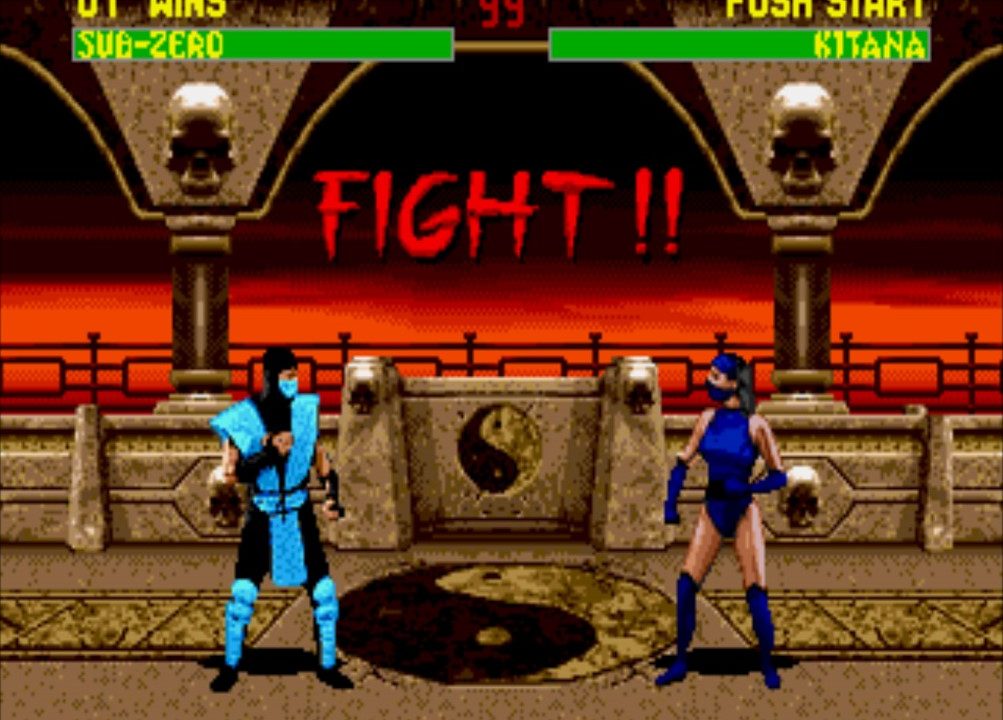Mortal Kombat II (Genesis version)
While Nintendo finally backpedaled on violence in video games with Mortal Kombat II, Sega maintained the status quo, albeit without the stupid “blood code” from their version of MK1. Unfortunately, as with MK1, the SNES version is a lot closer to the arcade version than on the Genesis.
Yet to its credit, Sega’s MK2 was more polished than their MK1 version with better visuals and upgraded sound. Some of the translations in gameplay and style were more authentic to the arcade version on the Genesis. Therefore, I don’t loathe it nearly as much as MK1. (Which I honestly don’t care for at all on any of the consoles.)
As for gameplay, MK2 was a major update over MK1. The roster of playable characters was expanded, as were the number of finishing moves. However, it wasn’t just the amount of fatalities that could be performed by each character, but the addition of “babalities” and “friendships” which increased the appeal of MK2. Former hidden fighter Reptile became another palette swap playable character as did MK1 boss Shang Tsung (who retained his ability o change into other characters!)
A number of series staples such as “Toasty”, more pit/stage fatalities, and a handful of other secrets bring this to the forefront of fighting games. In my opinion, MK2 was the best of the series and still hasn’t been topped since.
Mortal Kombat II (SNES version)
Nintendo finally backpedaled on violence in video games with Mortal Kombat II. Having a longstanding policy for being “family friendly”, Nintendo neutered the original Mortal Kombat on the Super Nintendo by replacing the blood with “sweat” and changing all of the game’s fatalities.
With MK2, Nintendo left the game alone and didn’t censor any of it. I recall pre-ordering this game and buying it at Hills Department Store!
As with MK1, the SNES version is a lot closer to the arcade version than on the Genesis. (To its credit Sega’s MK2 was more polished than their MK1 version.)
As for gameplay, MK2 was a major update over MK1. The roster of playable characters was expanded, as were the number of finishing moves. However, it wasn’t just the amount of fatalities that could be performed by each character, but the addition of “babalities” and “friendships” which increased the appeal of MK2. Former hidden fighter Reptile became another palette swap playable character as did MK1 boss Shang Tsung (who retained his ability o change into other characters!)
A number of series staples such as “Toasty”, more pit/stage fatalities, and a handful of other secrets bring this to the forefront of fighting games. In my opinion, MK2 was the best of the series and still hasn’t been topped since.
Mortal Kombat (SNES version)
Prepare for a deluge of fatalities and body-ripping reviews on one of my favorite series of all-time… well, at least the 2-D versions.
Mortal Kombat was a trendsetting series in many aspects. Each console version has its strengths, weaknesses, and differences, plus Acclaim (who released the home versions of the game) had different developers help depending on which console the game was released on. They also hashed out a ton of variations over the years, milking the cash cow for what it’s worth.
MK itself caused a ton of controversy with blood and guts and gore. As such, Nintendo neutered the blood and original fatalities from the original game when releasing it on the Super Nintendo. For example, Sub Zero’s spinal cord rip became a freeze and smash fatality (which actually made its way into sequels).
There was sweat instead of blood and while the Super Nintendo version had superior graphics and audio and was a closer arcade translation than that of the Genesis version (due to Sega’s inferior hardware) it was still a monumental success, but also inadvertently sent fans flocking to buy a Genesis console for the more violent version.
Stay tuned as I review the other versions, including Sega’s MK1 plus Nintendo caving and allowing the blood and gore in Mortal Kombat 2 for the SNES.
